Darryl Newman Jr. calls middle school “the best three years of my life, especially Mrs. French’s class.”
Marianne French was Darryl’s social studies teacher at Mill Creek Middle when he was in sixth grade. He said he has known since the first grade that he wanted to be in front of a K-12 classroom.
This year, the senior narrowed the grade he intends to teach to middle school, thanks to a five-month stint in her classroom as part of the district’s second year offering a teacher cadet program. He will start at Northern Illinois University in the fall, and plans to focus on middle school education.

“I loved everything about going to school: seeing my friends, learning about the world,” Darryl said. “I cried when the school year was over.”
Comstock Park’s teacher cadets spend the first semester of the yearlong course observing classrooms in all district buildings, to get a feel for which grade level they would most like to try their hand at teaching. They also study learning styles, create lesson plans and work on their presentation skills.
So far, Darryl has led classroom discussions and acted as French’s assistant by answering student questions, passing out assignments and, once, grading quizzes.
“When he wrote to me to ask if he could be a cadet in my class, I knew right away who it was,” French said. “You could ask any other teacher here who had (Darryl) and they will tell you he was so sweet and such a good student. He had great enthusiasm in the classroom. On the mark all the time, asking what he could do extra. And so respectful.”

Minority Shortage Persists
This year in intermediate school districts across Michigan, males account for 23 percent of all teachers, a number that mirrors national figures. Just 6 percent of all teachers in Michigan identify themselves as black/African-American, according to Mi School Data from 2007-2016.
It’s a somewhat exclusive club that looks like it’s getting even more so, according to the Learning Policy Institute. A 2016 report tracking trends since 1987 found “a persistent gap between the percentage of minority students and the percentage of minority teachers.”
Even though there was a 22 percent increase in the number of male teachers between 1988 and 2012, there were 4 percent fewer black teachers in American public schools in 2012 than there were in 2008, the institute found.
Darryl said he has never had a black male teacher, and wonders if, as for him, black males might shy away from teaching due to past experiences as students and not feeling equally treated by teachers of other races.

That’s something Darryl said he experienced firsthand. In elementary school, he said, his teacher often kept him inside during recess to work on his cursive penmanship. Though other students struggled, he said he felt singled out, put down and graded more harshly than his white peers. His parents ultimately moved him to another class.
It would take more than that to deter his career goal.
“I could be a doctor, a lawyer, anything else. I don’t want to be those things. I want to teach.”
CONNECT











